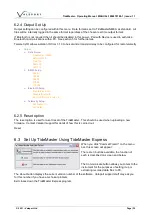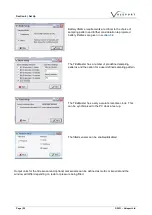
TideMaster - Operating Manual: MANUAL-1094978189-1 | issue: 1.1
© 2021
– Valeport Ltd
Page | 30
7.1.3 Site Calibration
The aim of a site calibration is to derive a suitable gain
and offset value by measuring the relationship between
pressure and tide at the top and bottom of the tidal range.
Measuring this relationship at two points on the tidal
curve will allow the gain and offset to be derived. This is
done automatically in the instrument using the following
formulas:
Gain = (H2
– H1)/(P2 – P1)
Offset = H1
– (P1 * (H2 – H1)/(P2 – P1))
To ensure the best possible fit, it is recommended the two points are measured at the extremes of tidal
range i.e. high tide and low tide. If waiting for a tidal cycle is impractical then it is possible to mimic a tidal
cycle by raising the transducer by a known amount. This is described below as the moving transducer
method.
Site Calibrations can be carried out using either of two methods:
•
Fixed Transducer Method
•
Moving Transducer Method
The factor determining whether a fixed or moving transducer calibration should be performed is determined
by how the transducer is mounted.
The fixed transducer method, as its name suggests, is used when the mounting of the transducer is static
and thus cannot be raised or lowered. Two readings are taken, one at low tide and one at high tide, and the
gain and offset calculated.
The moving transducer method can be used when the transducer is mounted on the Valeport slide wiring kit
(or similar construction) thus allowing the unit to be raised and lowered in the water column to simulate the
change in water level of the rising or ebbing tide.
















































